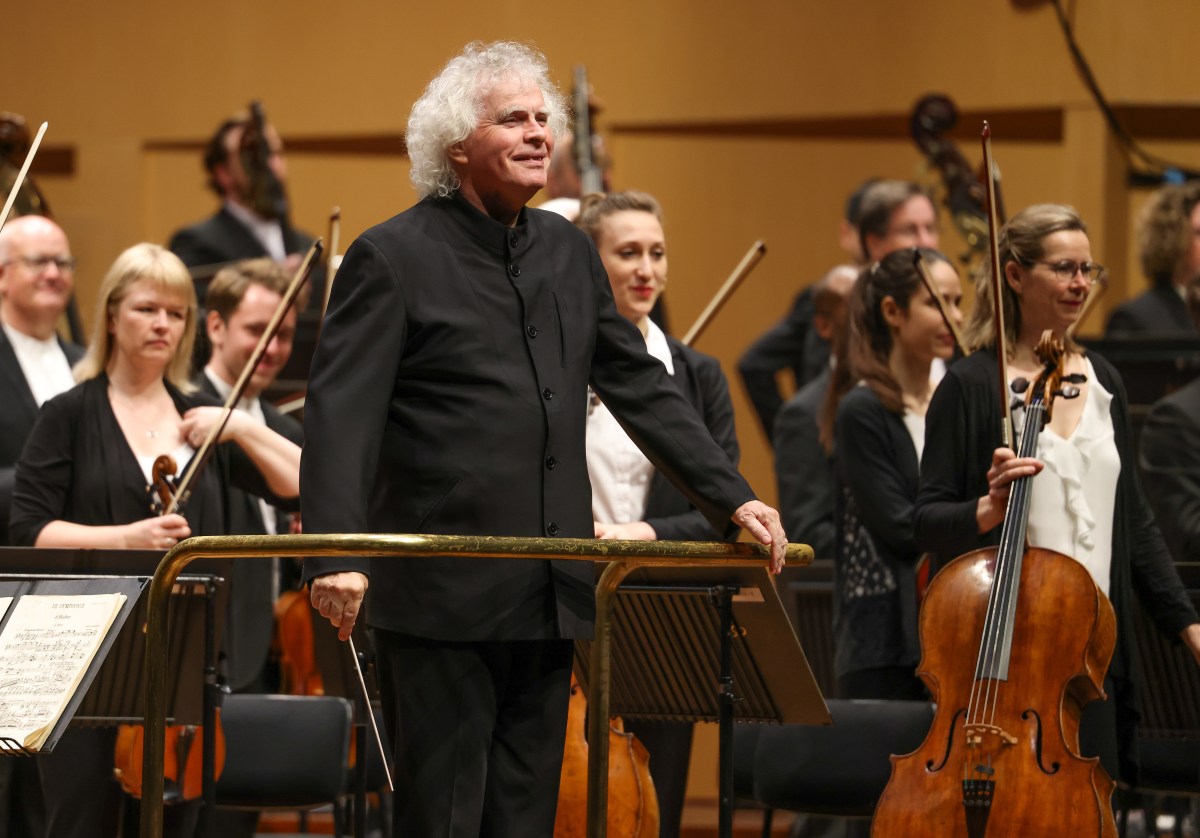The Seventh Symphony of Mahler is considered a problematic work and is the least performed of all his symphonies. Sir Simon Rattle himself has called it ‘the black sheep’ of the symphonies, while speaking warmly of its merits. For detractors, its construction, with five movements, is strange, while its transformative ending could appear out of context with the rest of an otherwise dark, mainly neurotic, work. Others, including Rattle, point to a work that is ingenious and compositionally complex, and well in advance of other contemporary works when it was written in the early 20th century.
With Rattle’s strong endorsement, Mahler’s Symphony No.7 in E minor has a rightful place in the programming that the LSO and Rattle have chosen for their current Australian tour. Their first concert, with works by Adams, Debussy and Ravel, offered cohesiveness through an overarching lyricism and an emphasis on a wide-ranging palette of musical colours and textures. For the second concert program, the Mahler 7, a seemingly controversial and lesser-known symphony, was an equally valid choice, given its expressive and highly colourful and textural sonority. All four works not only offer the chance to show off the diverse and impressive range of the orchestra’s skills and repertoire, but also give us a distinct blend of pieces that have compositionally much in common.
Rattle’s predilection for Mahler is well-known, and he conducted without a score, knowing it so intimately that he offered the most commanding and exciting interpretation, wondrous in detail, and adding greatly to an understanding of the composer and this work. Rattle’s approach in bringing every nuance of the score to life in as truthful and as passionate a way as possible allowed the narrative to unfold clearly. His process, which ensures that nothing the score demands is missed or overlooked, was helped by his often commented-upon conducting style. On the podium he was an energetic and animated fireball. He talked to and engaged with the orchestral players – encouraging, coaxing, pointing or jabbing at individual musicians or sections. A wonder to behold.
The Seventh Symphony’s overarching theme was set up in the first movement, ‘Allegro risoluto, ma non troppo’, suggesting a ‘tragic night without stars’. A very slow, tentative start by the brass was both menacing and restless, as the work then opened up expansively to the full orchestra, under Rattle’s careful and assured baton. Trumpet calls matched by hushed strings gave onto mystical harp glissandi followed by shrill high violins that heralded the brief arrival of stars. Beautifully paced, this section was aurally quite lovingly delivered. The coda offered wild, frenetic playing with Rattle in full control, while astonishingly he managed to highlight individual instruments amid the cacophony.
The two ‘Night Music’ movements wrapped around the third scherzo movement, ‘Schattenhaft’ or shadowy. Movement 2, ‘Nachtmusik – Allegro moderato’, had nightmarish connotations, the horn and piccolo solos among others morphing into a chirpy march in all the sections. The fourth movement, ‘Nachtmusik 11 – Andante amoroso’, was written as a refreshing romantic serenade with guitar, mandolin and tenor horn and pleasingly offered charming, gentle solos from violin and woodwind. It was lightly played.
The scherzo movement is the heart of the symphony. Though it has some entertaining waltz-like elements, it is a decidedly macabre piece. Mahler wrote some very interesting clicking, short sharp notes and bows hitting the wood for the strings, adding the high shrill violins to the mix with a strange dance macabre to finish. A hugely difficult movement to play, and certainly to conduct, it was handled expertly, with every note clearly delineated.
The fifth and final movement commences with huge orchestral forces, suggesting that we are seemingly emerging from night into bright sunlight. It was conducted powerfully with almost overwhelming dynamics that were kept hovering around the edge of chaos. The narrative is filled with astonishing light and shade instrumentation, a vast range of colours and textures offering a fierce running rhythm that Rattle controlled magnificently. It was as if Mahler decided to give everything to this movement, including the addition of cowbells to give it that Mahlerian pastoral feel. And it was a powerful ending to the work.
Most other conductors would be wrung out after 80 minutes of non-stop high-intensity Mahler. But Rattle bounced back immediately, offering encores, much to the audience’s delight. For a complete change of pace, Fauré‘s delightful and lightly played Pavane was first, followed by one of Dvorak’s Slavonic Dances, the 7th dance in C-major. Immensely tuneful and deliciously spirited, this was a perfect ending.
Rattle brought integrity, intelligence and sheer brilliance to Mahler’s Seventh Symphony, seamlessly gliding from movement to movement and never losing focus on the intent and arc of this complex and at times confusing work. There was an exhilarating freshness and vitality to the symphony too, as if we were hearing every note for the first time.
Read: Music review: London Symphony Orchestra: Adams, Debussy and Ravel, QPAC
Rattle not only inspired his musicians with his inclusive conducting style, he breathed with them and brought the audience on that journey too, so that this was very much a shared experience in the Concert Hall. ‘You had to be there’, as someone nearby in the auditorium so rightly stated on the night. The audience’s spontaneous standing ovation that went on for some minutes, only increasing after the two bonus encores, was testament to the palpable excitement that was felt in the QPAC Concert Hall.
QPAC presented London Symphony Orchestra’s Gustave Mahler on one night only on 29 April 2023.
The London Symphony Orchestra and Sir Simon Rattle will perform at the Sydney Opera House Concert Hall, May 1-3; and at Hamer Hall, Victorian Arts Centre, Melbourne, 5-6 May.





